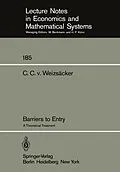I was originally induced to think about barriers to entry by some re search done for Charles River Associates, Inc., Boston, on behalf of their client IBM Corporation, Armonk, N.Y. After the end of this re search project I continued to work on entry barriers and related is sues of market structure. The results of this effort are reported here. What I present is not a book in the traditional sense of the word. Due to other research and administrative obligations I could not, without substantial delay, present a more finished product. The rapid progress in the field of industrial organisation theory made me fear that my results could become obsolete if I further waited with their publica tion. I hope that the early presentation of a progress report rather than a much later publication of a finished product is not only in my interest but also in the interest of economics.
Inhalt
1 The General Theoretical Framework.- 1. The Three Levels of Competition.- 2. Barriers to Entry and Externalities.- 3. Entry Deterring Strategies.- 4. Measuring Entry Barriers.- 5. Multidimensionality of Entry.- 6. Policy Implications of the Concept.- 2 Absolute Cost Advantages and Barriers to Entry.- 1. Superior Efficiency.- 2. Patent Rights as Cost Advantages.- 3. Cost Advantages due to Ownership of Scarce Resources.- 4. Conclusion.- 3 Economies of Scale without Intertemporal Links.- 4 Economies of Scale with Intertemporal Links.- 5 Product Differentiation: Goodwill I: The Basic Model.- 1. The Extrapolation Principle.- a) An Utopia with efficient resource allocation.- b) Monitoring of employees and job market signalling.- c) The Vertical Integration Problem.- d) Goodwill as a source of information about product quality.- e) A note on some recent developments in game theory.- 2. A Model of Goodwill.- a) The Consumer.- b) Market Equilibrium.- c) Long Run Equilibrium and Entry Conditions.- d) Barriers to Entry and Goodwill in the Model.- 3. The Meaning of Rational Expectations and the Extrapolation Principle.- 6 Product Differentiation: Goodwill II: Informational Activities.- 1. Efforts to Provide Quality Information (Signalling).- 2. Bias Against Newcomers.- 3. Product Testing.- 4. Economies of Scale due to Goodwill.- 5. Conclusion.- 7 Capital Requirements and Barriers to Entry.- 1. Risk without Moral Hazard.- 2. Asymmetric Information as a Distortion of Entry in the Presence of Risk.- a) How to Define Efficiency when Subjective Probabilities are Variable.- b) A Model of Risk Spreading with Moral Hazard (Asymmetric Information).- c) Project Size and Distortion.- 3. Implications for Capital Requirements as Entry Barriers.- a) The Distortions Discussed are of the Externality Type.- b) Bias of Financial Intermediaries.- c) Capital Requirements and Risk: The Leasing Example.- d) Correlated Risk.- e) Risk and Strategic Entry Deterrence.- 8 Barriers to Entry in Progressive Industries I: Strictly Sequential Innovations.- 1. The Three Level Framework as a Basis to Study the Relation of Entry Barriers and Technical Progress.- 2. A Simple Model with Strictly Sequential Innovation Structure. The Case of a Strictly Stationary Environment.- 3. The Influence of Market Size and Market Growth.- 4. The Influence of the Degree of Progressiveness and of the Price Elasticity of Demand.- 9 Barriers to Entry in Progressive Industries II: Competing Innovations.- 1. The Equilibrium and the Optimum Number of Competing Innovations for a Given Timing of Innovations.- 2. The Timing of Competing Innovations.- 3. The Equilibrium: Comparative Static Analysis.- 4. The Optimum.- 5. Evaluation.- 6. Some Policy Implications.- a) The Patent Issue.- b) Predatory Pricing.- c) Price Competition between Consecutive Innovations.- 10 Conclusion.- References.
